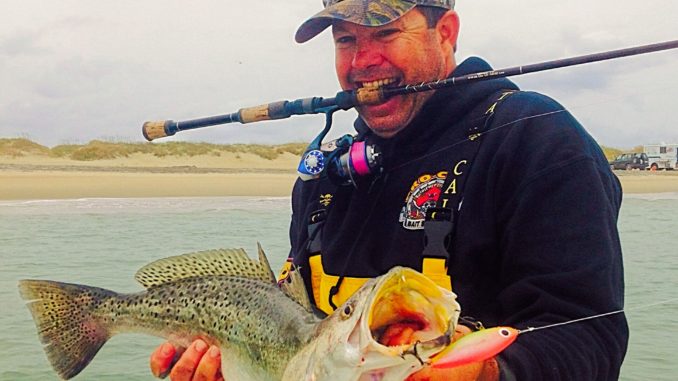
Cape Lookout’s dominant structure holds winter fish
North Carolina winters often are unpredictable, but one spot doesn’t seem to be affected much by roller-coaster mercury readings: the Cape Lookout rock jetty.
“You can catch big specks, red drum and sometimes flounder there,” said guide Noah Lynk of Harkers Island, N.C., (252-342-6911). “Caught a 9-2 speck last year out there; it’s my biggest one.”
The jetty rocks extend at a 120-degree angle to the northwest from the tip of the “hook” at Cape Lookout National Seashore. They’re submerged at high tide and a navigation hazard to unwary boaters.
“But it’s a really good place when the water gets cold quick on the inside,” Lynk said. “When it gets cold fast (in Back Sound), fish quit biting and move to the jetty.”
The tip of the South Core Banks resembles a fish hook with water between the point and Shackleford Banks protected by a pond-shaped oval. It holds warmth well, is slow to get cold during winter freezes, and fish become active. The jetty rocks also receive sunlight and hold warmth.
“But there’s not a lot for them to eat, so fish moving south come up against the rock jetty,” Lynk said. “The water temperature can be from the mid-50s to 60 degrees.”
Large trout are the main targets of anglers.
“MirrOlures are favored, but heavy, hard baits are good to use off the bottom,” he said. “Mud minnows or little pinfish work well, but you have to have saved up some.”
Lynk prepares for winter fishing by catching pinfish and mud minnows. He puts pinfish in bait pens and mud minnows in a 7-gallon bucket with holes punched in the sides and a pool noodle around the rim for flotation.
“You can fish them on a floating cork or a Carolina rig on the bottom,” he said.
Besides MirrOlures, he likes scented soft-plastic grubs from Gulp.
Lynk uses 7-foot medium-action Penn rods with 3000 or 4000 series reels spooled with 12-pound Penn braid.
“I like to anchor at a few favorite spots at the jetty,” Lynk said. “I don’t use a trolling motor.”
Wind direction and wave action determine ability to fish.
“When the wind gets above 15 knots, anything out of the west will be tough,” he said. “Northwest, southwest or south is hard to fish. A northeast wind blows straight offshore; you can take it up to 20 mph or more if you want to fish.”
Lynk prefers a high, falling tide.
“Most of the time, I fish in 4 to 10 feet of water with float rigs or on the bottom,” he said. “And you can catch gray trout out there, too.”



Be the first to comment